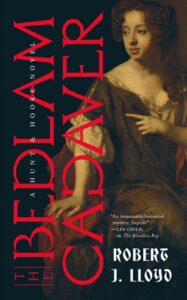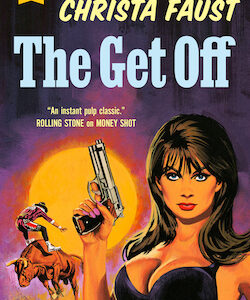The third book of my ‘Hooke & Hunt’ series, The Bedlam Cadaver, includes a building designed by Robert Hooke. And, indeed, includes the shortened version of its name in the title.
The Priory of the New Order of our Lady of Bethlehem was founded in 1247, its main purpose to collect alms to support the Crusader Church. By the 17th century, it specialised in the treatment—and confinement—of the insane. By now better known as the Bethlehem Hospital, or Bethlem, or Bedlam, it escaped the 1666 Great Fire, but was ‘very olde, weake & ruinous and to small and streight for keepeing the greater numbr of lunaticks therein.’ Its governors decided a new building was required; they appointed Hooke to design it and to oversee its construction.
Famous for his astronomy and his ‘Air-pump’, and as the Royal Society’s Curator of Experiments, Hooke might seem an odd choice for the role. But he was also Surveyor to the City, and a member of the committee which set the regulations for rebuilding a less combustible London. As such, he worked closely with Sir Christopher Wren, and had his own commissions as an architect. In the mid 1670s, when his new Bethlehem Hospital was built, Hooke was architect of the Royal College of Physicians, the Monument to the Fire of London, and the Greenwich Observatory. He built Montagu House, and also (a lot of alsos with Hooke) a house in Devon for Sir Walter Yonge, and another for the Earl of Oxford in Whitehall Palace’s Privy Garden. Hooke oversaw rebuilding Bridewell prison, the canalization of the Fleet River—a difficult and demanding civil engineering project—as well as the bridge at Holborn crossing it. He designed the Pepysian library in Cambridge. And the Tangiers mole in Morocco, damaged by a storm. All this while working with Wren on London’s churches—including St. Paul’s Cathedral—and providing demonstrations and experiments for the Royal Society Fellows.
Ground was purchased on Moorfields, just north of the Roman Wall. In April 1674, as his diary shows, Hooke conducted his first survey. The ditch left behind by the Romans was filled in, the foundations set into the rubble used to do so.
The Hospital was to be large enough for 120 patients—twice the capacity of the old one. The governors rejected Hooke’s initial design, two buildings to keep separate male and female patients. They wanted a grander scheme.
Hooke was fast and efficient. Within budget, between 1674 and 1677 he built the only building in London which looked like a palace. (Whitehall Palace, by contrast, was a messy sprawl of buildings.) He oversaw everything from its sewers to its ornamental gardens, the perimeter walls, and the patients’ exercise yard. He worked with Bethlehem’s physician, Dr. Thomas Allen. The two men were good friends, and Allen was a Fellow of the Royal Society. He’s another real person who appears in the story, as does his ‘Roome reported to be convenient for Docto Allen the Phisitian to open the Bodyes of Lunatickes’, as Hooke’s diary describes it. Allen, it’s known, conducted numerous post-mortems here for interested spectators. (An aside: Hooke asked Allen to provide ‘some mad person’ to carry out experiments on blood transfusion on them, but Allen—to his credit—refused to do so.)
Having tightly controlled the awarding of contracts and all expenditure, Hooke completed the Hospital for a modest £17,000. (According to the Bank of England’s ‘Inflation Calculator’, that’s just over £3,000,000 in today’s money, which to me just shows the difficulty of translating 17th century prices to modern day values.) For this sum, Bethlehem had two stories consisting of long galleries, some two hundred yards long. Each housed 60 patients. It was so large Roger L’Estrange wrote ‘…the Vast Length of the Galleries wearies [the] Travelling eyes of visiting Strangers.’
The patients’ rooms, each 12 feet by 9, were to the south side, with a long, well-lit corridor to the north. At first, the lower gallery housed the men, the upper the women, so they were ‘not suffered to lodge p[ro]miscuously together.’ In later years, the sexes were divided vertically, and new, ceiling-high metal grates installed between them.
To save money, most of Hooke’s Hospital was of brick. (Perhaps made using his brick-making machine, mentioned in his diary.) But in the centre and at the two ends were pavilions of stone, each with a large cupola. Beneath the galleries was a basement, with the kitchens and laundries and so on. This level had rooms rented by tradesmen and companies, including the East India Company, to store goods; the Hospital must have smelled of spices and pepper. This renting out of rooms brought in much needed money, for ‘mainteyning the poore Lunatiques.’ In fact, the building’s demise, in the early 1800s, was partly because more cellars were dug out to enable more storage. The back of the building (so, the patients’ side) subsided alarmingly, causing cracks in its fabric.
Another way of bringing in money was to allow visitors to view the Hospital and the patients within. A collection box stood near the entrance. Painted the same sky-blue colour as Bethlehem’s uniforms (for staff and patients), it had a slot for coins, and a brass plate inscribed with the words ‘Pray remember the poor lunaticks.’ In 1681, the year The Bedlam Cadaver is set, the Hospital’s Governors reported on ‘the greate quantity of p[er]sons that come daily to see the said Lunatickes.’ Asking them for charitable donations didn’t sufficiently cover the Hospital’s costs; although an entrance fee was never officially charged, the expectation was that at least a penny was paid. (The porter, possibly rerouting the money, encouraged it.) There’s even a report that one porter locked the exit until the visitors coughed up.
When my stories are set, the later Hogarthian image we have of the Bethlehem Hospital was not the case. It was still new. The ratio of staff to patients was far more generous than it became. (Hooke was instructed to provide servants’ rooms on each gallery, to prevent ‘Dainger that may happen among the lunatikes themselves when they are permitted to walke the yards there in the day tyme and alsoe that they be ready to prevent or suppresse any miscarriage that may happen by the said Lunatikes in the night tyme.’) Hooke designed the place to be well-lit and airy. The patients’ rooms had no glass in their windows, instead having grills of thin rods to allow in fresh air, thought to be therapeutic.
But as the Hospital’s records show, abuse of patients had already begun. The starting point of my story was finding out (while reading Jonathan Andrews’s unpublished thesis Bedlam Revisited: A History of Bethlem Hospital 1634-1770, which he’s kindly allowed me to use and quote) that, in 1681, two ‘basketmen’, Edward Langdale and William Jones, impregnated two of the patients. (The basketmen did the general work of the Hospital, including feeding the patients.) Mary Loveland and Esther Smyth were both speedily returned to their families, and had their babies. The Hospital’s Governors agreed to pay for their upkeep. They paid £20 per annum to Mary’s two brothers who now looked after her, and £5 to Esther’s brother John (a vicar in Woodhurst in Sussex) for the ‘charges of [her]. ..lyeing Inne.. .and. ..the childs funeral.’
Langdale and Jones were expelled from their employment, and Bethlehem’s porter and matron were ‘censured’ for their laxity in allowing the basketmen access to female patients. It may be reading between the lines too much, from this distance in time, but the matron being found ‘much to blame’ for allowing basketmen ‘to goe among the Lunatike woemen’ seems to me somewhat misogynistic. Be that as it may, the case was certainly enough for me to set about recreating Hooke’s Bethlehem Hospital, and gave me a motor for its plot.
***


















